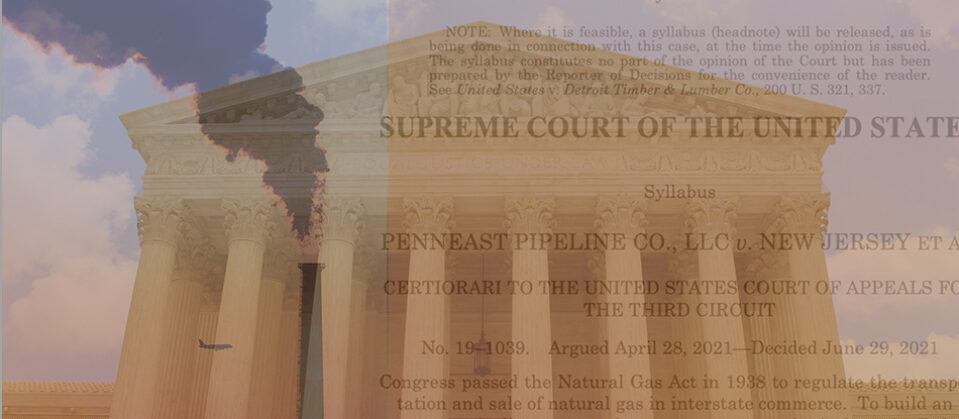A Supreme Court Roundup on States and Environmental Law
Bethany Davis Noll (Executive Director) / July 1, 2021

The Supreme Court wrapped up the 2020-2021 term this week, the first one with new Justice Amy Coney Barrett. It is a good time for a roundup of decisions involving states and the crucial issues that affect the nation’s grid and infrastructure as it grapples with a changing climate.
The blockbuster case at that intersection is PennEast Pipeline Co. v. New Jersey decided on Tuesday this week. In the case, the Federal Energy Regulatory Commission had granted PennEast a certificate under the Natural Gas Act to build a 116-mile interstate natural gas pipeline through Pennsylvania and New Jersey, including state-owned land in the Garden State. Under the Act, a certificate holder can exercise the federal government’s power of eminent domain to take land for its project. But New Jersey objected and argued that the Act did not clearly authorize PennEast to bring a condemnation action against a nonconsenting state. The Court held in a 5-4 opinion that because the Natural Gas Act authorizes the federal government to delegate condemnation authority to private parties, it also authorizes private parties to bring a condemnation proceeding in court, even if the landowner is a nonconsenting state. In holding that the state’s interests must cede here, the decision highlighted the role of federal condemnation power in “giv[ing] effect” to the vision of a “cohesive national sovereign” where the country is connected “through turnpikes, bridges, and railroads—and more recently pipelines, telecommunications infrastructure, and electric transmission facilities.”
A few other cases also involved states and environmental issues directly. Those cases gave small hints of a docket that will likely be shaped by extreme and changeable weather in the years to come. In Texas v. New Mexico, the Court interpreted the terms of the Pecos River Compact, an agreement governing the two states’ use of that river. After a tropical storm threatened flooding in Texas, the state asked New Mexico to hold onto some of the water, but then much of the water evaporated. The Court held that New Mexico should receive credit for the evaporated water under the plain terms of the agreement. In Florida v. Georgia, the Court held that Florida had not carried its burden of showing that Georgia’s upstream water use had caused Florida’s downstream oyster fishery to collapse. In an opinion written by Justice Barrett, the Court found that record evidence showed that seasonal rainfall change may have contributed to the decline, undermining Florida’s argument that Georgia’s overuse was at fault.
Beyond environmental cases, the Court’s recent decisions have also focused on standing—an important doctrine with the potential to affect state environmental claims. The doctrine governs whether a person or state can demonstrate harm necessary to bring a lawsuit in the first place. To show standing, plaintiffs have to show that the challenged action threatens or causes concrete and imminent injury and that the court will be able to actually fix the injury (“redressability”). In Texas v. California, the doctrine stymied a challenge to the Affordable Care Act, which was brought by a group of plaintiff states led by Texas. Plaintiff states had argued that the Act’s requirement that Americans obtain a minimum amount of health insurance rendered the whole statute unconstitutional. The problem with the plaintiffs’ case was that Congress made that requirement unenforceable by lowering the penalty for failure to obtain health insurance to $0. When the Trump administration nonetheless agreed with plaintiffs, California and a separate coalition of states intervened to defend the Act and argued that the plaintiffs did not have a right to challenge an Act that was not actually hurting them. The Court agreed with California, holding that plaintiff states had “not demonstrated that an unenforceable mandate will cause their residents to enroll in valuable benefits programs that they would otherwise forgo.”
In the coming years, the Supreme Court’s docket will likely continue to show the effect of a changing climate and be shaped by challenges to new policies coming out of the Biden administration. This term’s cases offer glimpses of the Court’s direction.
